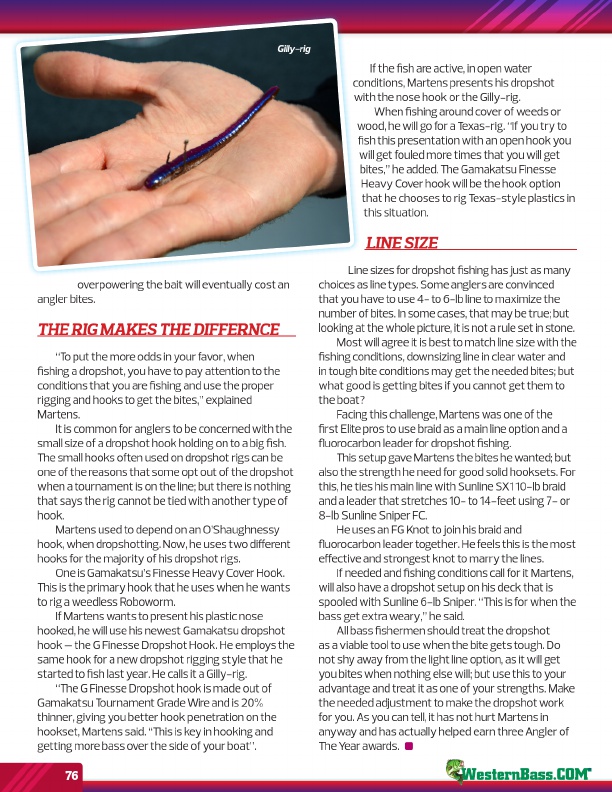
Gilly-rig
If the fish are active, in open water conditions, Martens presents his dropshot with the nose hook or the Gilly-rig.
When fishing around cover of weeds or wood, he will go for a Texas-rig. “If you try to fish this presentation with an open hook you will get fouled more times that you will get
bites,” he added. The Gamakatsu Finesse
Heavy Cover hook will be the hook option
that he chooses to rig Texas-style plastics in
this situation.
overpowering the bait will eventually cost an angler bites.
THE RIG MAKES THE DIFFERNCE
“To put the more odds in your favor, when fishing a dropshot, you have to pay attention to the conditions that you are fishing and use the proper rigging and hooks to get the bites,” explained Martens.
It is common for anglers to be concerned with the small size of a dropshot hook holding on to a big fish. The small hooks often used on dropshot rigs can be one of the reasons that some opt out of the dropshot when a tournament is on the line; but there is nothing that says the rig cannot be tied with another type of hook.
Martens used to depend on an O’Shaughnessy hook, when dropshotting. Now, he uses two different hooks for the majority of his dropshot rigs.
One is Gamakatsu’s Finesse Heavy Cover Hook. This is the primary hook that he uses when he wants to rig a weedless Roboworm.
If Martens wants to present his plastic nose hooked, he will use his newest Gamakatsu dropshot hook – the G Finesse Dropshot Hook. He employs the same hook for a new dropshot rigging style that he started to fish last year. He calls it a Gilly-rig.
“The G Finesse Dropshot hook is made out of Gamakatsu Tournament Grade Wire and is 20% thinner, giving you better hook penetration on the hookset, Martens said. “This is key in hooking and getting more bass over the side of your boat”.
76
LINE SIZE
Line sizes for dropshot fishing has just as many choices as line types. Some anglers are convinced that you have to use 4- to 6-lb line to maximize the number of bites. In some cases, that may be true; but looking at the whole picture, it is not a rule set in stone.
Most will agree it is best to match line size with the fishing conditions, downsizing line in clear water and in tough bite conditions may get the needed bites; but what good is getting bites if you cannot get them to the boat?
Facing this challenge, Martens was one of the first Elite pros to use braid as a main line option and a fluorocarbon leader for dropshot fishing.
This setup gave Martens the bites he wanted; but also the strength he need for good solid hooksets. For this, he ties his main line with Sunline SX1 10-lb braid and a leader that stretches 10- to 14-feet using 7- or 8-lb Sunline Sniper FC.
He uses an FG Knot to join his braid and fluorocarbon leader together. He feels this is the most effective and strongest knot to marry the lines.
If needed and fishing conditions call for it Martens, will also have a dropshot setup on his deck that is spooled with Sunline 6-lb Sniper. “This is for when the bass get extra weary,” he said.
All bass fishermen should treat the dropshot as a viable tool to use when the bite gets tough. Do not shy away from the light line option, as it will get you bites when nothing else will; but use this to your advantage and treat it as one of your strengths. Make the needed adjustment to make the dropshot work for you. As you can tell, it has not hurt Martens in anyway and has actually helped earn three Angler of The Year awards.
®